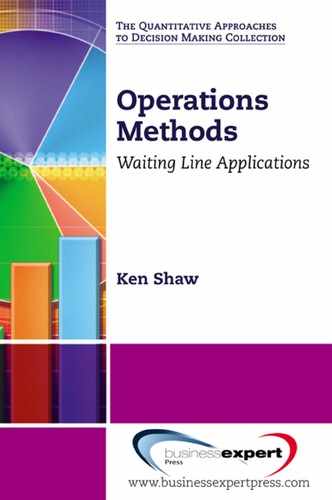Symbol Definitions
α Represents a parameter of choice in many equations. Do not assume that α represents the same thing throughout the text.
β Represents a parameter of choice in many equations. Do not assume that β represents the same thing throughout the text.
B Used as a subscript to indicate performance measures related to customers or items being blocked from entering the system because of limits imposed by the maximum number of servers and places (capacity) available.
C Represents cost in cost trade-off analysis. Various subscripts designate various types of costs: W, waiting time costs; S, server costs; B, blocking, balking, and reneging costs; L, line length costs; H, handling costs; E, equipment costs; F, facility costs; and $, finance costs.
Cx The coefficient of variation for the distribution of x. This coefficient is the ratio of the standard deviation of x to its mean,
![]()
D Represents a deterministic (constant) service or arrival time in Kendall notation for waiting line models.
! The math symbol for a factorial, which is a continuous multiplication of integers from 0 to n. That is, where 0! is defined as having a value of 1 and 1 × 2 × 3 × . . . × (n – 1) × n = n!
Ek Represents an Erlang distribution with shape factor k in Kendall notation for waiting line models.
E(n) The expected (mean) value of parameter n. Therefore, E(T) can represent the average time spent in a system.
G Represents a general independent distribution in Kendall notation for waiting line models. One example is a normal distribution for service or arrival times that are relatively constant but can vary by a small percentage.
i Used as a counter for a sequence of values in equations.
j Used as a counter for a sequence of values in equations.
K Represents the buffer size in Kendall notation for waiting line models (the number of places available for waiting and service when the line length is limited).
k Shape factor for Erlang distribution. It can also be used as a counter for a sequence of values in equations.
L The average length of a line in a service process, including the customers currently being served. That is, the total number of customers or items in the system.
Lb The average number of customers waiting to be served in a multiple-channel service process when all the servers are busy.
λ The average arrival rate in number per unit of time.
λu The individual arrival rate per unit or customer in a limited population model.
λ′ The effective average arrival rate. For limited capacity models, λ′ = λ(1 – PK); for limited population models, λ′ = λu(N – L).
Lq The average length of the line waiting to be served.
M Represents a Markovian distribution in Kendall notation for waiting line models. This is usually an exponential distribution for service rate and a Poisson distribution for arrival rate.
µ The average service rate in number per unit of time.
N The maximum number of customers or items in a finite calling population (also called a limited population).
n The number of customers. It can also be a counter for a sequence of values in equations.
PH Represents a phase-type distribution in Kendall notation for waiting line models with more than one phase in sequence. One example of this is a Coxian distribution for two or more phases, where the restriction on entering the first phase first is relaxed.
PB The blocking probability. See also B and PK.
PK The probability that the number of customers or items in the system is equal to the maximum system capacity. It is often called the blocking probability with the alternate symbol PB.
Pn The probability of exactly n customers in a system during the given period of time on which the associated arrival and service rates are based. In many texts, this is expressed by P(n).
P0 The probability of no customers in the system during the given period of time on which the associated arrival and service rates are based. In other texts, this may be expressed as P(0) or even shortened to P0.
Π A math symbol for a continuous multiplication of a sequence of terms. A simplification of this function for a sequence of integers from 0 to n is called a factorial.
q Used as subscript to indicate values associated with the line awaiting service (not yet being served). Examples are line length and the time spent waiting in line.
ρ A utilization factor (λ/µ). Note: Some authors also use ρ as defined for ρs. This can be confusing when using multiple-channel queuing equations from other texts and references; be sure to check the author’s use of this symbol. In this monograph, ρ always represents only λ/µ.
ρs The utilization factor for a multiple-channel system (λ/sµ).
ρu The utilization factor for a single unit or customer in a limited population model.
s The number of servers or channels. In some textbooks, this value is represented by c or M. (These symbols are not used here to avoid confusion with the representation for a Markovian distribution in Kendall notation for waiting line models.)
Σ The math symbol for summation of a sequence of terms.
σ The standard deviation for a normal distribution.
u A subscript used to designate a unit value. This is particularly necessary in equations for limited population models.
Vx The variance for the distribution of x. Equal to σ2 for a normal distribution of x.
W The average total waiting time in a service process, including the time when being served.
Wb The average time spent waiting in line before being served in a multiple-channel service process when all the servers are busy.
Wq The average time spent waiting in line before being served.
